Recently, we have tested a dual SIM touchscreen cell phone for the first time. It was the Fly E160. Today, in our lab, we are going to abuse a handset with almost the same specifications: the Samsung B5722.
Unlike the Fly, the B5722 features TFT capacitive touch screen. It makes the phone not only more user-friendly but also more durable and scratch resistant. By the way, life expectancy of capacitive touch screens is 300 million touches in a single location while resistive touchscreens withstand only 35 million touches.
In the dark box, as well as the phone itself there is a charger, a set of headphones, a USB Cable and a cell phone case (Pic. 1, 2). The dimensions of the B5722 are 104 x 54.9 x 14.5 mm. The gadget is equipped with Li-Ion battery (1200 mAh). In addition, in the box you’ll find a 2 Gb microSD.
At first look, the Samsung B5722 is a reliable mobile gadget with fine build quality (Pic. 3, 4). But how will it pass our tests? Read further to know the results.
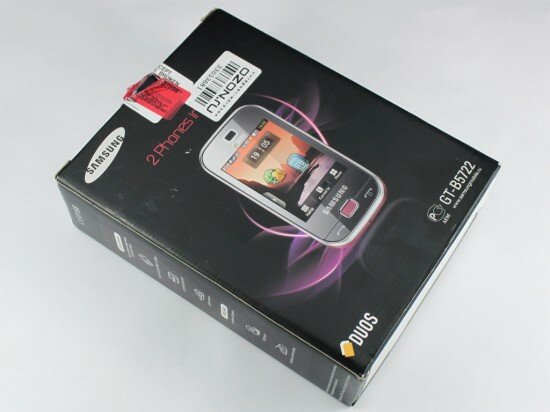
Pic. 1. Package box

Pic. 2. Accessories

Pic. 3. Samsung B5722 (front side)
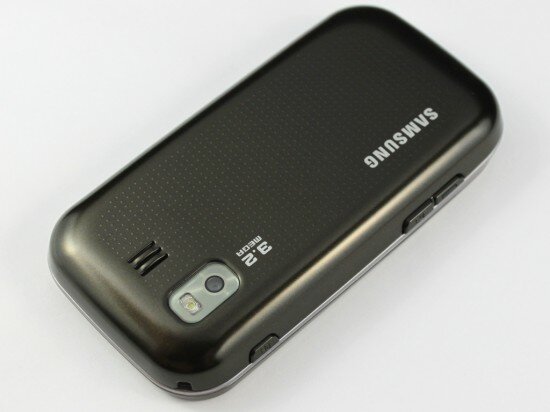
Pic. 4. Samsung B5722 (back side)
1. Samsung B5722 stress tests. Stage 1 — Light shocks
1. Drop tests
Like it or not, you’ll drop your cell phone sooner or later. Not every handset can stay functional after knocks and bumps. Let’s see what happened with the Samsung B5722.
At the first stage of this test, we successively dropped the phone on the carpet (video 1) from 1 m (3.28 ft) and on the ceramic tiles (video 2) from 30 cm (11.8 inches).
The Samsung B5722 can stand up to the slight bumps with no problem.
Video 1. Drops on the carpet from 1 m (3.28 ft)
The grade is 30 (with 30 being the highest possible grade)
Video 2. Drops on the tile from 30 cm (11.8 inches)
The grade is 30 (with 30 being the highest possible grade)
1.2 Squeeze test
The Samsung B5722 has a fine build quality. The back cover clings tightly to the phone. It doesn’t cave in or squeak. Both the front and the back panels are smooth. We can infer that due to this design the handset may withstand heavy loads.
In this test, we did the following: we placed the B5722 on a table and applied a 3 kg (6.6 lbs) pressure from a wooden bar above it (Pic. 5). The navigation key worked when the bar was pressed upon the phone. It happened because the key protrudes a little bit above the front panel. The Samsung sustained no damage.
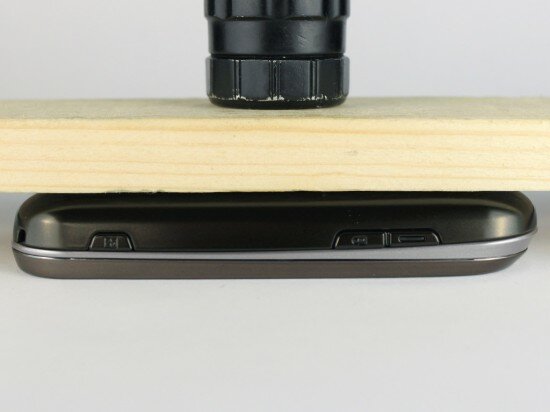
Pic. 5. The phone under the 3 kg (6.6 lbs) wooden bar
The grade is 24 (with 24 being the highest possible grade)
1.3 Bend test
Large handsets are very prone to bends because of their size. Sooner or later, it damages the elements of the circuit board, the touchscreen and the display.
We put the Samsung B5722 onto the two planks so that each edge of the phone lies on a single plank. Then we hitched a string with 1 kg load (2.2 lbs) on top of the device.
As a result, the handset didn’t show any bend.
The grade is 24 (with 24 being the highest possible grade)
1.4 Durability
Durability of mobile gadgets is expressed through their ability to withstand small-amplitude bumps. For this experiment, we use a special drum filled with plastic balls, pennies, and keys – the small things that we are used to keep in our pants pockets. We placed the phone inside this drum and rotated it for 5 minutes at the speed of 500 rpm (video 3).
The test showed that the Samsung B5722 is made of a low quality plastic material. We saw a lot of scuffs on the corners of the back panel (Pic. 6). The front panel, on the contrary, looked like new (Pic. 7). The gunmetal effect edging, the keys and the screen showed no damage.
Video 3. Drum rotation
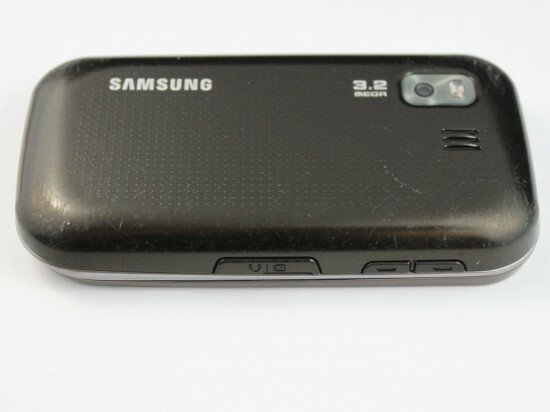
Pic. 6. Scuffs on the corners of the back panel
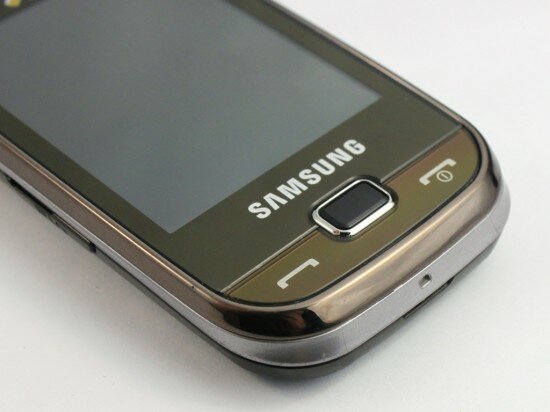
Pic. 7. The sides and edges stayed fine
The grade is 10 (with 15 being the highest possible grade)
1.5 Scratch test
In order to test scratch resistance of the phone, we successively scratched the screen and the back panel with the help of a nail that was fixed in a plank. The force of scratches was 100 g (0.22 lbs) (video 4). As you may see from the video, the Samsung B5722 sustained no visible scratch.
Video 4. Screen scratching
The screen gets 15 points (with 15 being the highest possible grade)
The back panel gets 15 points (with 15 being the highest possible grade)
1.6 High temperature
At the first stage of the test the Samsung B5722 was exposed to high temperatures for a short period of time. The device was placed in a metallic container 5 cm from the electric bulb (40 Wt) which heated it for 3 min. (video 5).
As we thought, the handset successfully passed this test. The temperature of the phone rose to 70 °С (158 °F) which is not much.
Video 5. Heat test
The grade is 12 (with 12 being the highest possible grade)
1.7 Dust test
Water and dust resistance of mobile gadgets shouldn’t be underestimated. Small grains of dust may inflict real damage. We witnessed how dirt broke the keys of the phones for several times, e.g. the Nokia C5.
In this test, we threw the Samsung B5722 inside an enclosed tray containing dust. Then we made it vibrate viciously for 2 min.
After the test, we examined the phone (Pic. 8). At first glance, the handset seemed fine. The battery slot was clean (Pic. 9). The plastic cap protected the USB port which happens very seldom. We saw some grains of dust there but in general the result was excellent (Pic. 10). Had we cleaned the phone from dirt, we noticed that quite a lot of dust penetrated under the protective screen glass (Pic. 11). We discovered that tiny grains of sand seeped through the gap in the lower right corner of the screen. We found the reason later when we disassembled the phone.
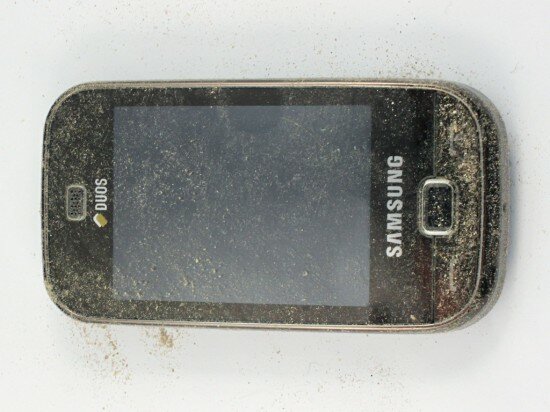
Pic. 8. Here's how the Samsung B5722 looks like after all the tests
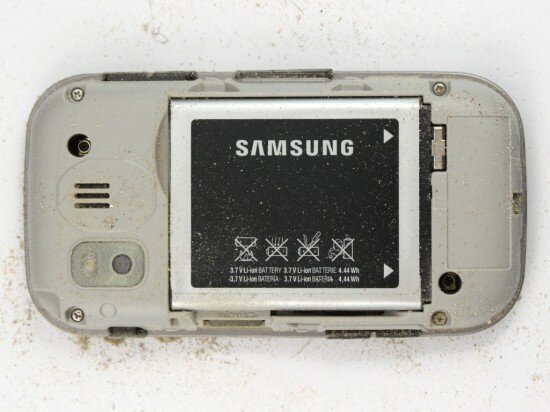
Pic. 9. The battery and the slot are clean
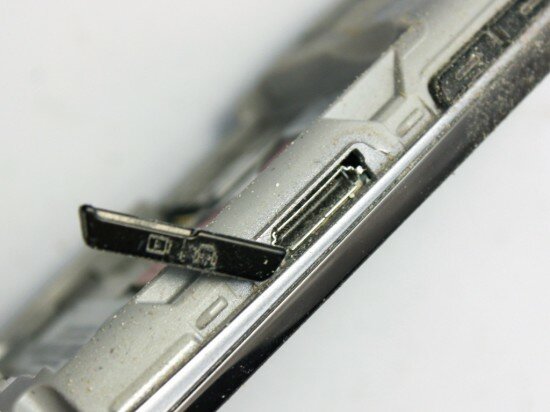
Pic. 10. No dust in the USB port
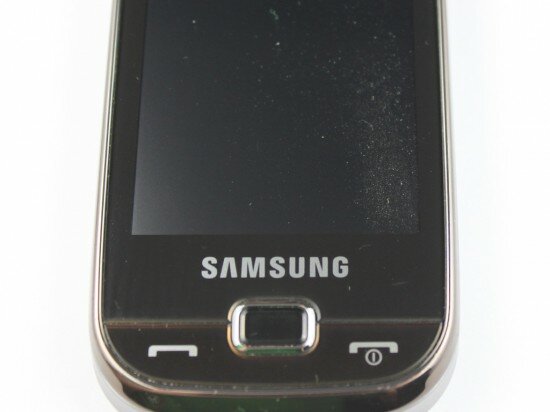
Pic. 11. Small grains of dust under the protective screen glass
The grade is 8 (with 12 being the highest possible grade)
1.8 Signal strength test
The Samsung B5722 has two operating systems. The two SIM cards can work simultaneously. But how does it affect the signal strength of the phone? The following test will give us the answer.
We placed the handset inside a box. Then we foiled the box (the foil served as a shield). This considerably reduced the signal from towers. However, we made a 40 x 45 mm (1.57 x 1.77 inches) hole in the box through which the phone could receive the signal. This hole allowed us to see the indicator of signal strength on the phone’s screen (video 6).
The majority of handsets pass this test with no problem. But the B5722 showed bad results. The first call that we made was dropped. A few moments later we received the notification about the call via SMS. In general, the phone didn’t receive two calls (with 10 being the maximum number of calls). Nevertheless, there were 4 – 5 bars on the indicator of signal strength during this test (with 6 being the maximum number of bars).
Video 6. Signal strength test
The grade is 10 (with 15 being the highest possible grade)
After the 1st stage of the stress tests, the Samsung B5722 got 178 (with 192 being the highest possible grade)
Samsung B5722 stress tests. Stage 2 — Tough conditions
2.1 Drop test
This time, we dropped the phone on the carpet (video 7) from 1.5 m (4.9 ft) and on the tile (video ![]() from 50 cm (1.64 ft).
from 50 cm (1.64 ft).
The gadget passed this test fine again. The back cover clung tightly to the handset.
Video 7. Drops on the carpet from 1.5 m (4.9 ft)
Video 8. Drops on the tile from 50 cm (1.64 ft)
The grade for the drops on the carpet is 30 (with 30 being the highest possible grade)
The grade for the drops on the tile is 30 (with 30 being the highest possible grade)
2.2 Squeeze test
We increased the applied pressure to 10 kg (22 lbs). The phone showed no damage.
The grade is 30 (with 30 being the highest possible grade)
2.3 Bend test
In this stage of the test, we increased the weight of the load to 5 kg (11 pounds). As a result, we saw a slight bend (Pic. 12), but the phone stayed functional.
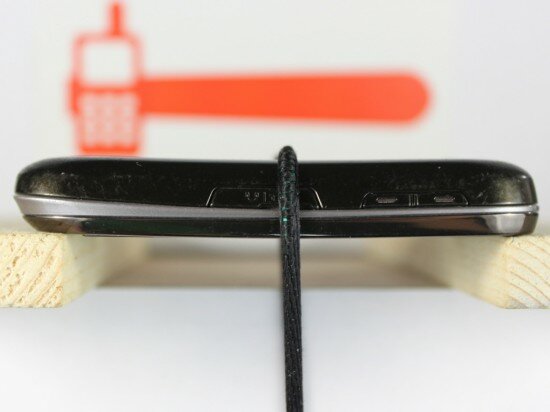
Pic. 12. Bend made by the 5 kg load (11 pounds)
The grade is 24 (with 24 being the highest possible grade)
2.4 Durability test
The drum filled with plastic balls, pennies, and keys, serves as a “time machine” because it aims to make gadgets look older. In this test, we rotated it for 10 minutes at the same speed.
The back cover showed more damage than in the previous durability test. Besides the scuffs, we saw a lot of deep scratches on the back cover of the phone (Pic. 13). As for the screen, it sustained only some minor scuffs (Pic. 14).
The gunmetal effect edging around the screen was completely destroyed in some locations.
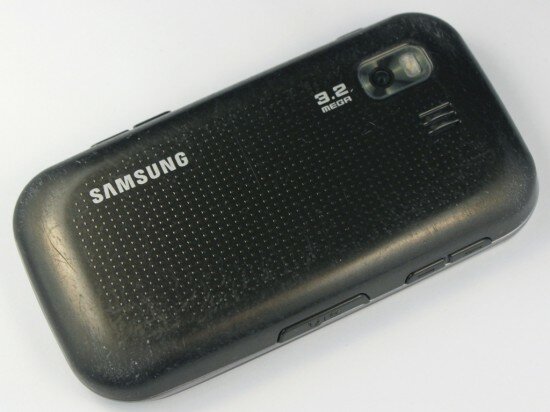
Pic. 13. Scratches on the back cover
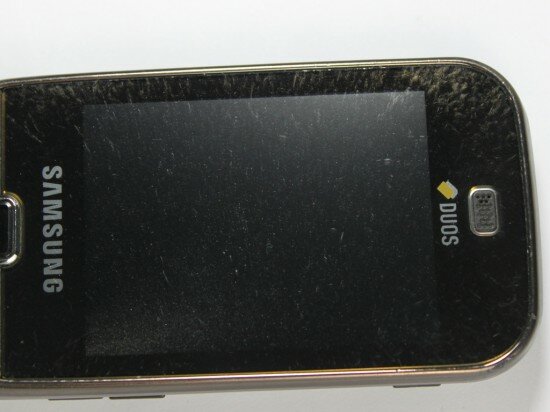
Pic. 14. Scuffs on the screen
The grade is 10 (with 15 being the highest possible grade)
2.5 Scratch test
We increased the force of scratches to 300 g (0.66 lbs) (video 9).
A capacitive sensor’s surface is always solid state and it allows to use a protective layer. The Samsung B5722’s screen is not so rigid as, for example, Gorilla Glass, because it is made of plastic. But it can also pass the scratch test without damages. Actually, we made a tiny scratch that was visible only in the bright lights.
Video 9. Screen scratching (the force of scratches is 300 g (0.66 lbs))
The screen gets 15 points (with 15 being the highest possible grade)
The back cover gets 15 points (with 15 being the highest possible grade)
2.6 Freeze test
Touch screen cell phones, especially with capacitive sensors, show very poor performance in winter time. It’s impossible to operate them in the gloves. In freezing temperatures, cell phone battery capacity goes down much faster compared to moderate temperatures. Besides, the displays start to malfunction which is annoying.
In this test, we took a box filled with ice cubes, placed the Samsung B5722 in it, and then placed the box in a freezer for 2 hours. The temperature in the freezer was -15…-20 °С (5 °F…-4 °F). The phone was left in speaking mode during that time.
When we took the handset out of the freezer its battery was empty (video 10). The phone switched to power save mode trying to prolong his lifetime before switching off. The backlight was weak and it disappeared faster, compared to the usual state of the phone. The display malfunctioned. The keys on the D-pad became stiffer but worked fine.
When we dried the B5722 to the normal temperature, the battery became full again.
Video 10. Freeze test
The grade is 12 (with 18 being the highest possible grade)
2.7 High temperature test
At the second stage of the heat test, the handset spent 5 min. in the “sun”. The increase of time changed nothing. The results were the same as in the previous experiment. The temperature of the phone rose to 84 °С (183.2 °F).
The grade is 12 (with 12 being the highest possible grade)
2.8 Immersion in water
Water damage is one of the most serious problems that your mobile phone may face. If you don’t take the battery out dry your wet handset the consequences will be awful. In this test, we dunked the Samsung B5722 under distilled water for 1 second (video 11). The touchscreen started to malfunction because the sensing surface got wet. Drops of water penetrated under the loudspeaker grill and spoiled the sound which became dull (Pic. 15). Some water penetrated in the battery slot through the gaps of the camera compartment and the polyphonic speaker. The cap of the USB port did a good job again – the connector stayed dry.
We dried the phone with warm air for an hour and it performed as fine as before this test.
Video 11. Immersion in water for 1 second
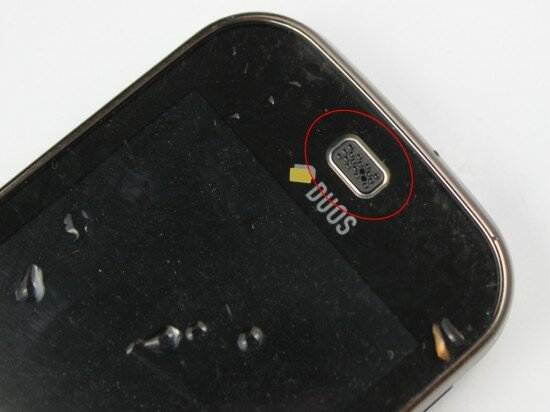
Pic. 15. Water penetrated under the loudspeaker grill
The grade is 30 (with 30 being the highest possible grade)
2.9 Dust test
This test lasted for 5 min and the result was almost the same as the previous time. A little bit more dust penetrated in the USB port (Pic. 16). Nevertheless, the Samsung B5722 passed this test better than the other phones. We are glad to say that the back cover is really tight because the battery slot was almost clean. However, more dust accumulated under the protective screen glass.

Pic. 16. Clean USB port
The grade is 8 (with 12 being the highest possible grade)
2.10 Signal strength test
We decreased the size of the hole to 20 x 20 mm (0.787 x 0.787 inches). This reduced the signal more than in the previous test (video 12).
But the result was pretty much same: 3 calls were dropped. The reception was a little bit weaker (7 calls out of 10). During the calls the signal indicator displayed 4 bars.
Video 12. Signal strength test
The grade is 10 (with 15 being the highest possible grade)
After the 2nd stage of the stress tests, the Samsung B5722 got 220 (with 240 being the highest possible grade)
3. Samsung B5722 stress tests. Stage 3 — The toughest conditions
3.1 Drop test
At the last stage of this test we dropped the phone on the carpet (video 13) from 2 m (6.56 ft) and on the tile (video 14) from 1 m (3.28 ft).
The handset didn’t sustain any damage during the drops on the carpet. The landing was so soft that it seemed that the phone fell on the sofa and not on the carpet. However, during the drops on the tile the back cover fell off for the first time in this test. We also noticed some small dents on the corners of the back cover. But they merged with the scratches inflicted in the previous tests and didn’t strike the eye.
Video 13. Drop on the carpet from 2 m (6.56 ft)
Video 14. Drop on the tile from 1 m (3.28 ft)
The grade for the drop on the carpet is 30 (with 30 being the highest possible grade)
The grade for the drop on the tile is 30 (with 30 being the highest possible grade)
3.2 Squeeze test
In this test, we increased the pressure we applied to 20 kg (44 lbs). The phone showed no damage and stayed functional.
The grade is 24 (with 24 being the highest possible grade)
3.3. Bend test
This time, we applied 10 kg (22 lbs) weight in our attempt to bend the Samsung B5722. The result was the same as in the previous test. We can infer that there is a frame inside the phone that makes it rigid.
The grade is 24 (with 24 being the highest possible grade)
3.4 Durability
At the last stage of the durability test we rotated the drum with the phone thrown in for 20 min.
This time the back cover suffered a lot. It became white in some locations and the handset itself looked like a pebble (Pic. 17). The gunmetal effect edging was deteriorated and here and there we witnessed black plastic instead of the gunmetal effect (Pic. 18). We also found more scuffs on the screen. Fortunately, it didn’t show any deep scratches and preserved original image quality (Pic. 19).
This is not the first Samsung cell phone that is made of a low quality plastic. The test of the Samsung Champ serves as the example.
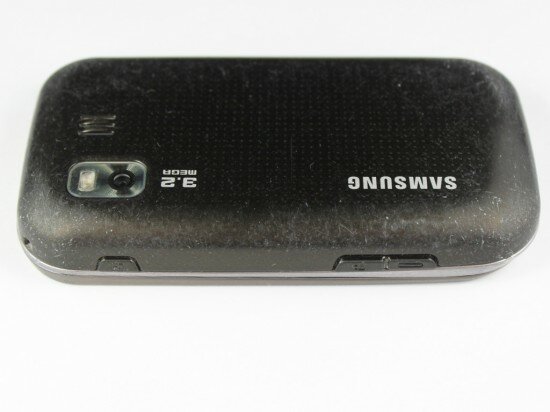
Pic. 17. The gap between the back cover and the panel
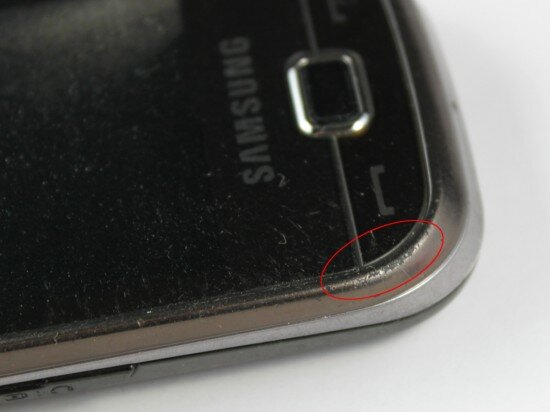
Pic. 18. Deterioration of the gunmetal effect edging
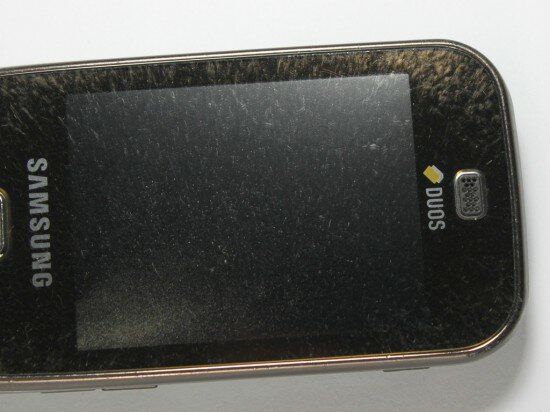
Pic. 19. Here is how the screen looked like after this test
The grade is 10 (with 15 being the highest possible grade)
3.5 Scratch test
We increased the pressure we applied on the nail to 600 g (1.322 lbs) (video 15, 16). This time we made a visible scratch on the screen (Pic. 20) which ruined the quality of the picture (Pic. 21). The back cover also showed a big scratch (Pic. 22)
Video 15. Screen scratching
Video 16. Back panel scratching
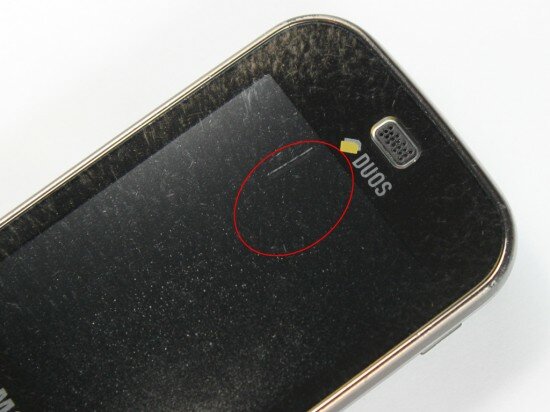
Pic. 20. Scratch on the screen
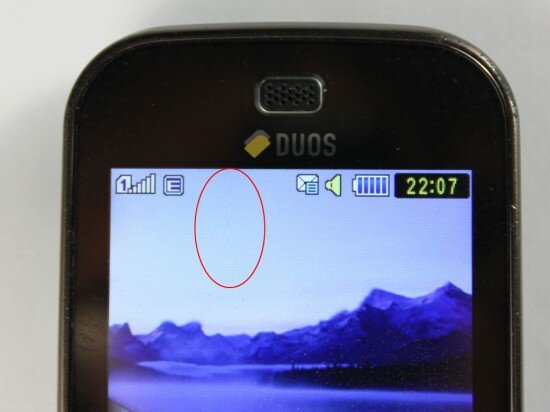
Pic. 21. That's how the quality of the picture is ruined
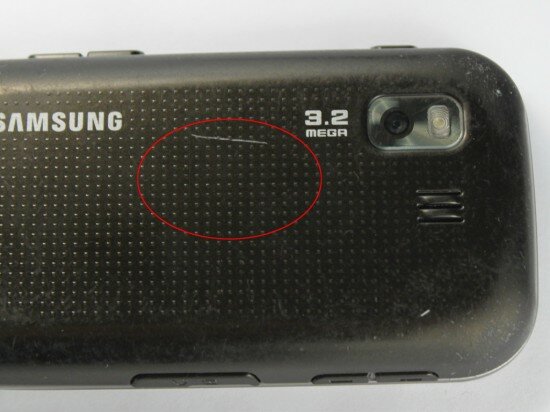
Pic. 22. Scratch on the back panel
10 points for the screen (with 15 being the highest possible grade) for the screen
10 points for the back cover (with 15 being the highest possible grade) for the back cover
3.6 High temperature test
We increased the time of this test twice. The phone lay “in the sun” for 10 min. (video 17).
When the time of the experiment was over it started to smell like a melted plastic. This smell wasn’t very strong and we thought that the handset wouldn’t sustain any visible harm. Unfortunately, we were mistaken. The lower part of the touchscreen was covered with a number of cracks (Pic. 23). When we took the Samsung B5722 out of the container we saw a big black spot on the screen. This spot disappeared when the temperature of the phone became normal. During the test the bulb heated the phone to 107 °С (224.6 °F).
As a result, the appearance of the screen deteriorated. But the performance of the phone and the touchscreen was fine.
Video 17. High temperature test

Pic. 23. Cracks on the screen
The grade is 8 (with 12 being the highest possible grade)
3.7. Immersion in water
It’s time to dunk the Samsung B5722 under water for the 2nd time. The test lasted 20 sec. (video 18). The touchscreen performed perfectly afterwards. For the rest, the result is the same as the previous time.
After the experiment we dried the handset with warm air for an hour.
Video 18. Immersion in water for 20 sec.
The grade is 30 (with 30 being the highest possible grade)
3.8. Immersion in beer
We decided to change water for more dangerous liquid: beer. Actually, we dunked the Samsung B5722 under beer for 10 sec. (video 19).
At first glance, nothing strange happened to the phone. Despite the dull sound and the sensor malfunctions, the performance of the phone was fine. We could make calls with no problem. However, much beer penetrated in the battery slot. We saw the drops of beer even under the battery.
We dried out the handset after the test. When we switched it on we saw a spot in the lower part of the screen. It was made by beer (Pic. 24). Drops of beer and grains of dust accumulated in one and the same corner under the protective screen glass. As for the rest, the phone stayed fine.
Video 19. Immersion in beer for 10 sec.
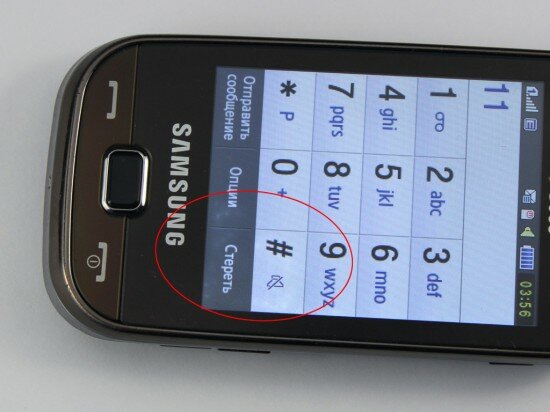
Pic. 24. Drops of beer under the protective screen glass
The grade is 9 (with 9 being the highest possible grade)
3.9. Dust test
We threw the Samsung B5722 inside the enclosed tray containing dust and shook it viciously for 10 min.
The large gaps of the loudspeaker grill stayed clean (Pic. 25). A bit more dust penetrated in the battery slot and under the battery (Pic. 26). Many small grains of dust penetrated under the protective screen glass and accumulated in the corner (Pic. 27). This spoiled the picture on the screen. The USB port was clean as usual.
We should also say that the keys performed perfectly.
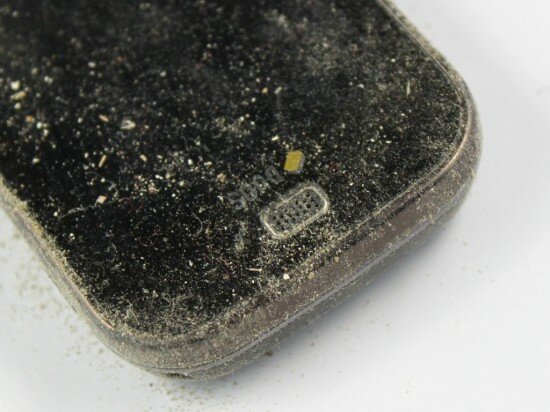
Pic. 25. Dust didn't block the loudspeaker grill
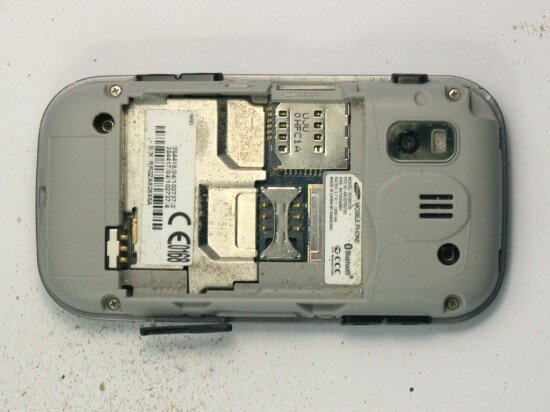
Pic. 26. Dust under the battery
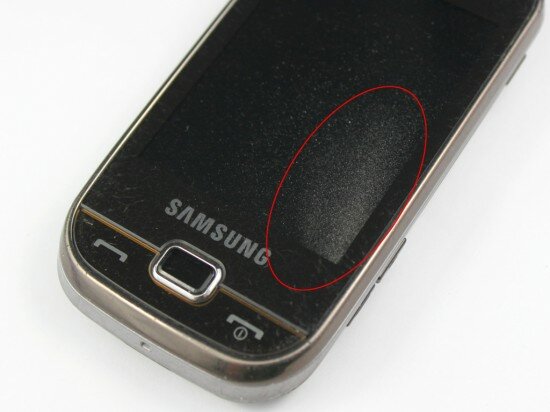
Pic. 27. Dust under the protective screen glass
The grade is 8 (with 12 being the highest possible grade)
3.10. The keyboard
The keys of the D-pad are made of transparent plastic. They are quite durable. The keys on the sides of he phone are made of black plastic and they were damaged during the tests.
All the time the keys worked pretty fine. They became a bit stiffer only when we took the phone out of the freezer.
All the keys are compactly arranged and look smart. In general, the keypad is top notch.
The grade is 30 (with 30 being the highest possible grade)
3.11 Signal strength test
We decreased the size of the hole in the shielded box to 15 x 15 mm (0.59 x 0.59 inches) (video 20).
The reception was minimal. Sometimes the signal indicator showed 4 bars. The phone received less than a half of the incoming calls. Moreover, connection was unstable, the speed of the dials was low and some calls were dropped.
Video 20. Signal strength test
The grade is 5 (with 15 being the highest possible grade)
3.12 Short circuit and overcharge
The last tests of this review are aimed to reveal the Samsung B5722’s ability to withstand electrical overloads. At first we wanted to know what would happen to the battery charger if we made a short circuit of the power supply terminals with the help of the forceps for 1 second (video 21).
The battery charger survived the short circuit with no problem.
Video 21. Short circuit of the battery charger
Then we shorted the contacts “+” and “-” with the help of the forceps for a moment (video 22). The battery stayed safe and full. The phone performed successfully with this battery inside it.
Video 22. Short circuit of the battery
Next, we checked the reaction of the gadget on increase and decrease in charging voltage. We increased the charging power to 8 V with the help of the PSU (video 23). The B5722 continued to consume the same amount of energy as it does in normal charging conditions. It means that the charging circuits work fine.
Then, we decreased the charging power. The handset stopped to consume current at 4.1 V. This is also a good result.
Video 23. Increase/decrease in charging voltage
Finally, we found out what could happen to the circuit board if the energy supply was extremely high or low. Actually, we took the battery out of the slot and plugged the PSU into the phone (video 24).
We started increasing energy supply and simultaneously watched how much current the phone consumed. According to the indicator, the phone consumed 5 times more current than it usually consumes in normal conditions.
This is a drawback of all Samsung cell phones. However, the extremely high energy supply didn’t break the phone.
We decreased energy supply to 3.1 V the phone switched itself off.
Video 24. Increase/decrease in energy supply
For the ability to withstand short circuits the battery charger gets 15 (with 15 being the highest possible grade)
For the ability to withstand short circuits the battery gets 15 (with 15 being the highest possible grade)
For the ability to withstand increase/decrease in charging voltage the Samsung B5722 gets 15 (with 15 being the highest possible grade)
For the ability to withstand increase/decrease in energy supply the Samsung B5722 gets 10 (with 15 being the highest possible grade)
3.13 Disassembling
After all the tests, we disassembled the Samsung B5722. As we thought, there was a steel frame inside the phone that made it rigid (Pic. 28, 29). We also found the reason why dust penetrated under the protective screen glass: the corner of the glass was not appropriately attached to the panel. As a result, there was a gap through which dust and beer penetrated deep inside the phone. We saw the evidence of beer on the frame that was located right under the screen (Pic. 28).
Most of the Samsung cell phones have circuit boards with soldered and compounded chips (Pic. 30). The Samsung B5722 is not the exception. Such design of the board makes it uncomfortable to disassemble and repair the phone.
At the same time it makes the B5722 more reliable in everyday use. However, both of the two steel shields are not soldered to the circuit board.
For the build quality the gadget deserves the highest grade, though we overestimated it a little bit.
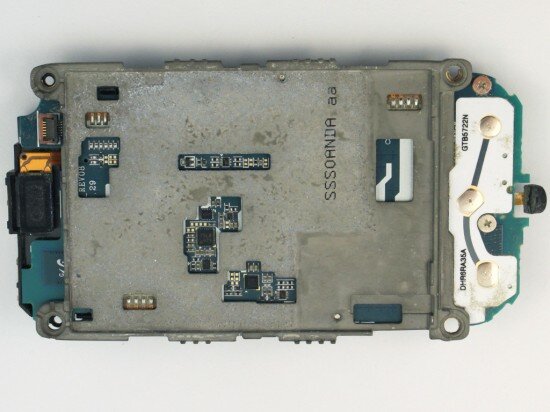
Pic. 28. Steel frame
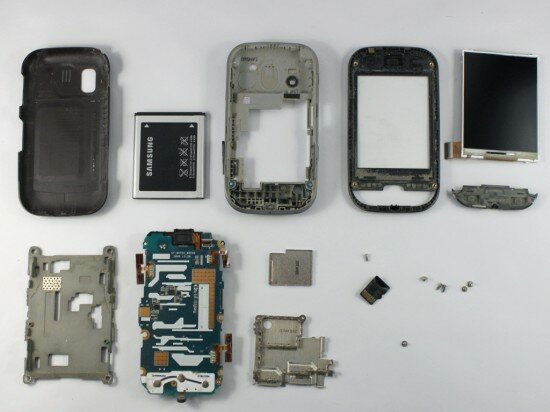
Pic. 29. The Samsung B5722 disassembled
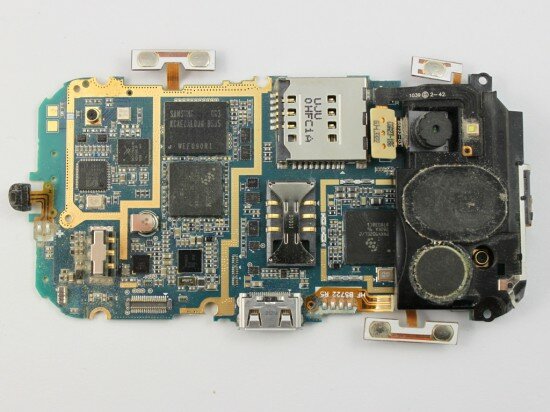
Pic. 30. The Samsung B5722's circuit board
The grade is 15 (with 15 being the highest possible grade)
After the 3rd stage of the stress test, the Samsung B5722 got 313 points (with 351 being the highest possible grade)
Conclusion
Finally, we’d like to sum up the results of the stress tests and mention all the advantages and disadvantages of the Samsung GT-B5722 DUOS.
We start with the drawbacks as usual. But is the phone really guilty in failing some of the tests? The answer is “No”. And we’ll prove it.
For example, dust accumulated under the screen only because the protective screen glass wasn’t properly attached to the panel. But we lowered the grade for the handset in all the three dust tests. We can’t deny that this was the only model with the defect of the screen.
The same can be said about the reception. We can’t find the answer why the signal was so weak.
The last and the most objective disadvantage is the quality of the plastic of which the gadget is made. We can also mention the strange performance in cold weather and that’s all.
The main advantage of the Samsung B5722 its build quality: the back cover is tight, the keys are compactly arranged and comfortable to use.
The handset survived bending and drops on carpet and on the tile.
Despite the small spots on the screen, the phone showed no damage and stayed functional after the immersions in water and in beer.
The touсhscreen and the D-pad are quite durable (unfortunately we can’t say the same about the other parts of the phone).
The gadget is able to withstand electrical overloads.
Video 25. Here’s how the Samsung B5722 looks like after all the tests

Pic. 31. Here's how the front side of the phone looks like after all the tests
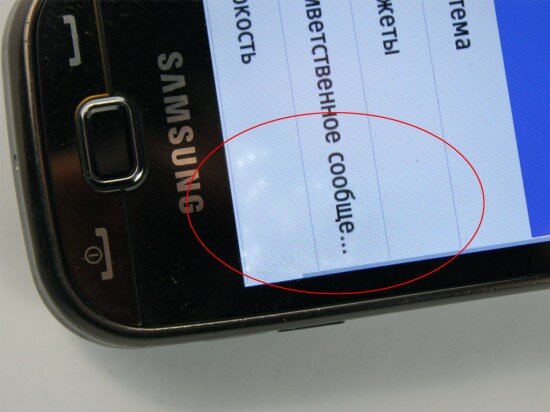
Pic. 32. Here's how the screen looks like after all the tests
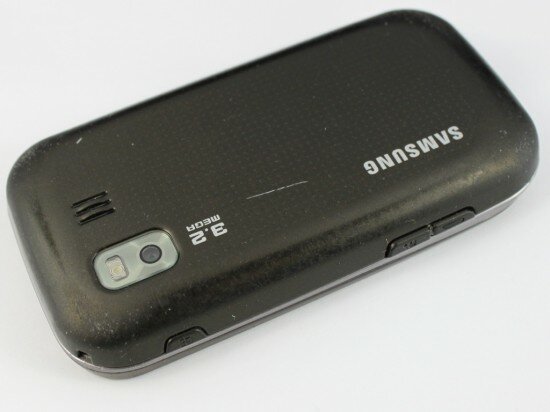
Pic. 33. Here's how the back side of the phone looks like after all the tests

 Russian version
Russian version
Comment (1)
The immersion tests are good; but need to be more modified for more liquids like salt water (seas) and Soap water.
Sea water deteriorates the circuit lot quicker than any other liquid. It also has the potential of damaging the screws of the body which keeps the body attached to the main board. Thus unabling the unscrewing of the main board and body separate.
Soap water can also be as damaging as sea water (salt water), damaging the internal circuits. Soap water due to its more viscosity penetrates the internal parts very quickly than any other liquid.